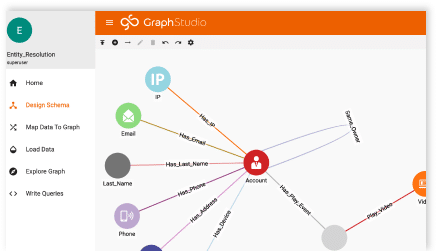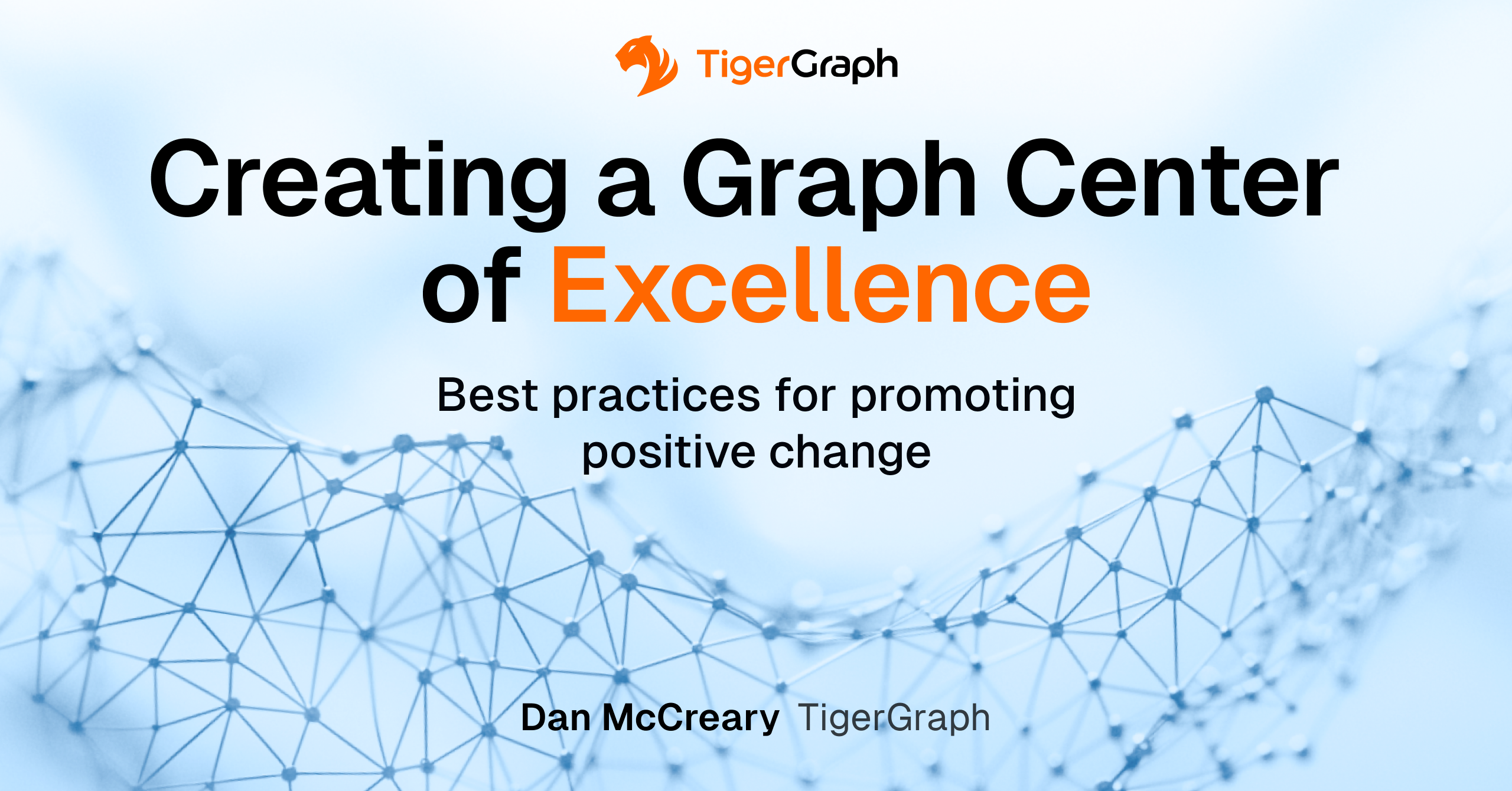Best practices for promoting positive change

In today’s high-velocity change-driven business climate, organizations are increasingly turning to specialized teams known as Graph Centers of Excellence (Graph CoEs) to stay ahead of the curve. More than any other database architecture, graph databases are becoming the foundation for intelligent agents. A Google Scholar search shows almost 3,000 papers on “Graph Machine Learning” and over 65,100 papers on “Graph Embeddings.” No other database technology (Relational, Analytical, Key-Value, Column-Family, or Document) comes even close to aligning AI-powered intelligent agents and graph databases.
This blog explores what a Graph CoE is, why it’s gaining popularity, the challenges in getting one started, its various types, and critical operational strategies such as building a portfolio of use cases, sharing success stories, tracking return on investment (ROI), and fostering training and advocacy.
Let’s start with a story. This story concerns a large Fortune 100 organization with many isolated business units. When a new Distinguished Engineer joined the company, they did not find a single graph application in production. After some research, they found an underground community of graph-aware developers, but most didn’t even know the other graph-aware developers existed! Just by hosting some lunch-an-learn sessions, they found camaraderie, and together, they found an executive sponsor who helped get their first graph application into production. The key difference was not any technology change but better communication between graph-aware solution architects who understood the impact that graph technology could have on the company.
What Is a Graph Center of Excellence?
A Graph Center of Excellence is a focused group within an organization that uses graph technology to standardize workflows, tools, and methodologies and to drive innovation. Graph technology primarily involves data structures that use nodes and edges to represent and store data. The CoE’s role is to champion graph technology by promoting best practices, offering support and training, and implementing solutions that help the organization leverage connected data for enhanced decision-making.
Graph CoEs don’t need to have full-time dedicated staff. They are frequently composed of graph-aware staff from many different parts of an organization, including technical, management, marketing, and leadership.
Graph CoEs don’t just connect people to technology. They connect people. They allow knowledge about how graphs benefit an organization to spread faster with lower friction. Graph CoEs help dispersed graph evangelists know they are not alone and are in a community of like-minded people. They become an exchange of ideas, helping organizations promote positive change.
Take Our Survey!
Here is a short four-question survey to help us understand what you want from a Graph Center of Excellence.
https://forms.gle/pTD15N8pmLo59b3T8
Why Organizations Are Creating Graph CoEs Now
With the explosion of data in recent years, traditional data management strategies need to be revised. Organizations deal with increasingly interconnected data, necessitating tools that store vast amounts of information and maintain the relationships within that data. Graph technology addresses these needs, making it possible to visualize complex networks, from social connections and supply chains to fraud detection, cybersecurity, and beyond.
The ability to quickly notify a business of anomalies in complex structures can help transform organizations. Tools to analyze interdependencies and connections can lead to more insightful business decisions and innovations. A CoE consolidates expertise in this niche yet increasingly crucial area, enabling organizations to deploy these technologies more effectively.
Challenges in Starting a Graph CoE
Creating a Graph CoE is challenging. It often requires a significant initial investment in the time of your most strategic thought leaders. Finding professionals who know the potential of graph databases and have leadership skills can be demanding. Training existing staff in graph capabilities requires a focus over an extended period. Integrating graph technologies into established systems poses challenges, from technical integration hurdles to resistance from current employees accustomed to traditional data management tools.
Strategies for Countering Status Quo Bias

This statement is a classic example of what we call status quo bias. Status quo bias is a cognitive bias in which people prefer things to stay the same by doing nothing or sticking with a previous decision. This bias arises from the natural human resistance to change because change often involves effort and the potential for loss. This bias can hinder innovation and adaptation in business, technology, or personal growth. Individuals and organizations may avoid new methods or technologies, even if they offer significant improvements.
Giving a name to this bias is the first step in helping people recognize it exists and how to counter it. We also cover other types of cognitive bias in our CoE discussions with our customers, but recognizing this bias is a great starting point.
Building a Portfolio of Use-Cases
One of the first tasks of a newly formed CoE is to establish a strong portfolio of use cases that demonstrate the value of graph technologies. A use-case portfolio involves selecting projects with a high chance of success and significant business value. Early wins are crucial for gaining organizational support and funding for future projects. These use cases should be diverse, covering different aspects of the business, from marketing to operations, to showcase the versatility and impact of graph technologies.
Sharing Success Stories

Communicating successes internally and externally is vital for a CoE. Success stories not only motivate team members but also help in building credibility across the organization. These narratives highlight the challenges faced, the solutions implemented, and the benefits realized, providing a blueprint for future projects and encouraging more widespread adoption of graph technologies.
Tracking ROI
Demonstrating the ROI of graph technology investments is crucial to securing ongoing support and resources from stakeholders. This tracking involves tracking direct financial gains and evaluating improvements in efficiency, risk management, and customer satisfaction. Metrics should be established from the outset, and data should be gathered continuously to provide a robust picture of performance and impact.
Training and Internal Change Advocacy
For a Graph CoE to be successful, it must also focus on training and advocacy. Both training and advocacy go hand-in-hand. The CoE can facilitate technical training and promote cultural change within the organization. Advocacy involves demonstrating the value of graph technology to the broader organization and cultivating a mindset that embraces data connectivity and innovation.
Building an Idea Pipeline

An effective Graph Center of Excellence (CoE) thrives on a continuous influx of innovative ideas that can be transformed into practical graph database applications. Building an idea pipeline is crucial for maintaining this flow of creativity and ensuring the sustainability of the CoE’s initiatives. This section outlines how to create a web form for creativity and then reviews these ideas for suitability for graph database tasks.
Creating a Web Form for Ideation
The first step in building an idea pipeline is to develop a platform where team members can easily submit their new graph ideas. A simple web form can be an ideal tool for this purpose, as anyone within the organization can access it anytime. The form should be simple yet comprehensive, asking for essential information such as:
- Idea Title: A brief, descriptive title of the idea.
- Description: A detailed explanation of what the idea entails and how it might be used within graph technologies.
- Expected Benefits: An overview of the potential benefits and impact on the organization.
- Relevant Data Sources: Identification of data sources that the idea would leverage, which helps assess feasibility.
- Resources Required: Suggestions on teams or business areas that must work together to make this project happen. Sometimes, getting cooperation from diverse teams in different business areas is a crucial obstacle to making graph projects a reality.
This web form should be linked to a backend database where submissions are stored, tracked, and analyzed. The process should be user-friendly to encourage participation in your Graph CoE idea pipeline, and the importance of every contribution should be recognized.
Reviewing Ideas for Suitability
Once submitted, ideas must be reviewed to determine their suitability for development into graph database projects. This review process should involve a diverse panel that includes CoE members, data scientists, IT specialists, and business stakeholders. The review panel should consider the following criteria:
- Alignment with Business Goals: The idea should support the strategic objectives and needs of the organization.
- Feasibility: Consideration of the technical and practical feasibility of implementing the idea using existing resources and graph technology capabilities.
- Impact: Evaluation of the potential effects on efficiency, revenue, customer satisfaction, or other relevant metrics.
- Innovation: The degree to which the idea utilizes graph databases in a novel or innovative way.
Each submission can be scored against these criteria to facilitate a systematic review. Ideas that meet a predefined threshold can then be advanced into the project planning and development phase.
Prioritizing Ideas
After the review, suitable ideas need to be prioritized. The review involves assessing which projects should be prioritized based on their potential impact, resource requirements, and the organization’s technology landscape. Prioritization helps manage resources effectively and ensures that the most valuable projects are launched promptly.
By systematically creating, reviewing, and prioritizing ideas through a structured web form and review process, a Graph CoE can ensure a steady pipeline of projects that leverage graph database technologies to solve complex problems and add value to the organization. This continuous stream of ideas fosters innovation and helps keep the CoE relevant and aligned with the evolving needs of the business.
Finding an Executive Sponsor

Finding a senior leader who is brave enough to challenge the status quo can be a critical factor for the long-term durability of your CoE. Change agents don’t have to understand all the technical details, but it would help if they could explain the “why graph” to others. Creating a solid collection of stories can help your team empower change agents to make the right decisions and guide others. Change agents have many techniques for creating a sense of urgency. Your CoE needs to listen carefully and learn from the lessons that work.
Writing a Graph CoE Charter

We have frequently helped teams start building a Graph CoE. A good charter can keep your group focused on sharing knowledge rather than being tasked with casting judgment on older architectures. If you would like to discuss these ideas, let me know. I can share a sample Graph CoE charter, and we can customize it to your organization’s needs.
Conclusion
While establishing a Graph Center of Excellence presents various challenges, the potential benefits are immense. Organizations can effectively harness the power of graph technology by focusing on strategic project selection, robust use-case development, success sharing, ROI tracking, and comprehensive training and advocacy. Many Graph Centers of Excellence enhance real-time data handling capabilities and foster innovation and efficiency, positioning the organization for future success in an increasingly data-driven world.
Please contact [email protected] if you would like to learn more about creating a Graph CoE and need help with a Graph CoE Project Charter.
Note: Here is a sample Graph Center of Excellence Project Charter.








